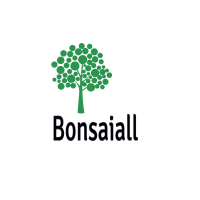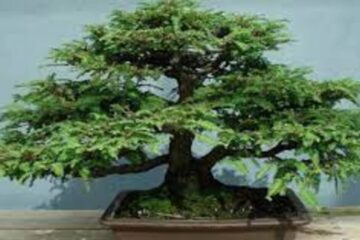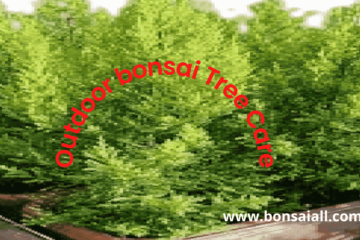Bonsai trees are beautiful plants that require special care and attention. They also take a long time to mature. If you want to start growing bonsai plants, you should know what kind of Bonsai soil mix they prefer.
Bonsai trees are valued for their unique shape and beauty. The roots of these plants are shallow and compact, making them ideal for growing in pots or containers, but they require good bonsai soil Mix.
Good bonsai Potting soil is capable of providing rich nutrients, water absorption, aeration and proper excess water drainage. Understanding what makes the best bonsai soil mix is important for healthy bonsai plants.
This article will cover all about bonsai soil mix and soil composition to help you understand the best bonsai soil available and bonsai soil requirements.
Learn more :The Ultimate Guides How to Make Bonsai pots from Clay?
Bonsai Soil Mix Guide
Content Overview
All of the above bonsai soil mixes that you can buy online or at garden centers are ready-mixed soil. Even though they’re ready to go, it’s still important to understand things like soil composition to know what’s best for healthy bonsai plant roots.
What is standard bonsai soil made of?
The type of bonsai soil you choose will depend somewhat on the bonsai species you are cultivating. Basic standard bonsai soil will be a mixture of layers of clay, lava rock, organic matter and pumice.
Although bonsai soil will vary from one brand to another, the basic ratio that is considered best for conifers is 1:1:1. It is one part lava rock, one part pumice and one part akdama, a naturally occurring granular clay. Maple trees and deciduous trees, in general, do better with a 1:1:2 ratio.
Some brands will include peat moss and pieces of tree bark in their mix, but these ingredients should be added discreetly. Exceptionally nutritious, but can hinder soil drainage and proper root aeration.
Bonsai soil aeration
Bonsai plants need oxygen to grow strong roots. If the roots are packed into a standard dirt and compost soil mix, they won’t have access to enough oxygen.
A loose bonsai soil mix leaves room for air to enter and circulate, so root systems benefit from proper ventilation and little air pockets.
Bonsai soil drainage
Well-drained soil is crucial to the health of your bonsai plant. If you plant your bonsai in a pot with standard garden soil and water it, the compacted dirt retains moisture in the soil. Bonsai roots will slowly sink because they have no access to oxygen.
Most bonsai species will not enjoy sitting in water, as it can cause the plant’s roots to rot. Root rot left untreated will kill your plant.
The right bonsai soil will have excellent drainage properties that allow any excess water to drain from the bottom of the bonsai pot after you finish watering.
Bonsai soil water retention
This may seem like a contradiction after reiterating the need for great extraction, but it is not.
Just because your plant doesn’t want to sit in water, also known as “wet feet,” doesn’t mean it doesn’t need water. If your plant is only planted in rock or gravel, the water will run out and nothing will remain, meaning the roots will not have access to the water they need to survive.
For this reason, bonsai soil types contain one or more components that retain water. Granular natural clay known as Akdama, originating in Japan, is a popular solution for retaining water when growing bonsai trees. This material is baked to provide a gravel-like substrate.Learn how often water you bonsai tree for better water to keep balanced water retention.
Nutrient value of bonsai soil
Bonsai soil contains little or no organic matter, so it will also have very little nutritional value for your plants. For this reason, regular fertilization of your plant is key.
The three nutrients most plants need are nitrogen, phosphorus and potassium. Your plant needs a bonsai fertilizer with these ingredients to keep it thriving.
Bonsai soil pH level
For most bonsai plants, soil pH levels should measure between 6 and 6.5. If the pH is high, the soil will be alkaline. When the pH is low, it is an acidic soil.
Proper bonsai soil fertilization will not only provide essential nutrients, but also help balance the pH level in the soil mix.
Alkaline plants are more common and are usually caused by lack of fertilization or poor water quality. A good bonsai fertilizer that contains sulfur can help regulate pH levels. You can measure the pH level with a soil pH meter.
How is bonsai soil different?
Bonsai soil is different from normal potting soil and is not recommended for use with plants other than bonsai plants. The composition and composition of the soil is different for bonsai plants to grow strong roots.
Bonsai mixes contain little to no soil. This helps keep the mixture loose and spacious, allowing for better airflow around the roots. This helps the soil mix to stay light and not compact as opposed to heavy mixes.
A typical bonsai mix will contain a large amount of inorganic material, such as diatomaceous earth or fired clay.
With houseplants, you need to provide nutrients, so organic soil and compost are preferable. Inorganic matter is best for bonsai plants.
Burnt clay will not rot or break down, so it holds the required amount of water but at the same time allows good drainage. Along with fired clay and diatomaceous earth, you’ll often find perlite or vermiculite.
Would succulent soil work well for bonsai?
Yes, loamy soil also does not break down very easily and is usually quite porous, meaning it offers good water retention and drainage at the same time. These properties make succulent soil suitable for use with bonsai as well.
When mixed properly, it will provide enough nutrients for your bonsai, just like any bonsai soil mix. However, when growing a bonsai, always research the species you are growing to ensure your bonsai soil mix meets the nutrient requirements for your bonsai plant.
How To Make You Own Bonsai Soil Mix?
Are you planning to take up the art of bonsai? Then the most important thing is to provide your small tree species with the right Bonsai soil mix.
It is very important to give your bonsai plants a good bonsai soil mix. Soil provides essential nutrients to your indoor or outdoor plants to prevent root rot.
The right bonsai soil mix also provides aeration and holds water. Where you can easily find ready-made bonsai soil.
You can save money mixing your soil, and it gives you control over what your plant species needs. Stay tuned as we suggest you with instructions on how to mix your own bonsai soil mix.
Is it a Bonsai Soil Mix or a Substrate
Credit : Planty.io
The most important part of the bonsai plant is the potting soil mix or a substrate. Most of the time, bonsai soil is overlooked because your plant species are trees, and soil is just soil. So, something should work.
No, because soil is more than pushing your spade into the ground and digging up a pile of dirt. So step one is done, and now we can move on to caring for our bonsai tree. Yet, when it comes to bonsai, you are a geologist, artist and horticulturist.
Why, you want to try to replicate nature because Mother Nature has been in the game for a long time and bonsai soil mix is made up of different gritty ingredients. So, your plant is not growing in soil but in a layer of bonsai soil mix.
Thus, you may see soil advertised as bonsai soil mix or bonsai substrate mix for bonsai indoor plants. So, whatever you use, the soil makes a difference because it has to provide optimal drainage.
Furthermore, your bonsai plant needs to have good water retention and drain freely through drainage holes. Finally, your plant needs good ventilation to provide oxygen to the roots and leaves for photosynthesis.
So, what is a good Bonsai soil mix? Find out.
Mixture of different types of bonsai soil mix
You now know the importance of soil mix for your plants. Should you use organic soil or inorganic soil, as you know regular potting soil won’t do.
When you see an organic bonsai soil mix, it contains dead plant material such as bark, peat moss or leaf litter. The problem you face with using organic garden soil is that the organic matter breaks down, so drainage decreases over time.
You can also see the ingredients decaying, so you don’t know how quickly the soil becomes harmful. Still, if you think you want to use organic soil with decaying plant matter, choose pine bark.
Another problem is that most potting compost does not absorb water well when dry. You find this in your inexpensive bonsai plants found at garden centers. You feel great. I watered my plant, and all the water ran down the side of your plant to the bottom of the pot.
Inorganic soil mixtures contain no organic matter such as calcined clay or igneous rock. Therefore, it absorbs less moisture and is suitable for ventilation and drainage. So, you have more control over the fertilizer you apply to the soil.
Still, you need a well-drained inorganic soil that allows for proper drainage so that fresh air can penetrate the soil. If compacted soil lacks structure, it will lack aeration along with drainage and degrade your plant’s health.
What soil material should you use?
Bonsai soil ingredients are mainly organic potting compost, fine gravel (grit), pumice, acacia, and lava rock.
Akadama
Akadama is a hard-baked Japanese clay used for bonsai. But if you buy it, remember that you have to drive it. After two years, it began to crumble and reduce ventilation. So, you end up with regular re-potting.
Or you should add it to your bonsai mix with other well-draining soil ingredients. Since it is expensive, you can substitute it with other similar baked clays. You can even add cat-litter to it.
Organic Compost
Bonsai soil mix uses sand, perlite and peat moss. When you use it by itself, the water holding capacity is very high. This leads to poor ventilation and drainage. But when used as part of other soils, it works well.
Fine gravel/Grit
Adding grit or gravel helps drain water immediately and keeps fine feeder roots aerated. You can use it as the bottom layer of your bonsai pot to improve drainage. Yet many bonsai users have stopped using it.
Pumice
It is a soft igneous rock that absorbs water and nutrients well. When added to the soil mix, it helps retain water for healthy root growth.
DIY bonsai tree soil mix
Before you start preparing your Bonsai soil mix, remember that not all plant species have the same soil needs. But there are two primary soil mixes for coniferous and deciduous trees. Both provide excellent ventilation and water retention.
However, it would be best to adjust this standard bonsai mix according to your location. For example, if you tend to your plants multiple times a day, you can add some organic soil with acacia to help retain water.
If you live in a humid climate, we recommend adding more crushed lava rock or gravel to increase drainage.
Coniferous and Pine Bark Soil Mixture
We recommend using 33% Lava Rock, 33% Pumice and 33% Akadama in your mix for drainage and aeration.
Deciduous bonsai soil
For deciduous trees, use 25% lava rock, 25% pumice and 50% acacia.
Basic Bonsai Soil Mix Steps
- Choose a medium-sized grain akdama for your soil mix.
- Next, sieve the baked clay to remove fine dust for proper ventilation and drainage of excess water.
- Now, add your pumice which requires no sifting and sift your lava rock into your potting mix.
- If your plant species needs a lot of water absorption, we recommend adding organic soil.
Tips when using bonsai soil mix
Soil naturally compacts over time, and it’s best to test a simulation of how the organic matter and layers will hold up. To simulate compaction before filling the bonsai pot, you should use your hands to tamp down the wet soil.
If your bonsai mix is compacted like a hard clump, then your soil has too much organic matter. Eventually, it will retain water and wet legs and roots can rot. Another issue is not having enough air pockets, which leads to more concerns.
If your soil mix separates from the hand, there is adequate drainage but not aeration. To solve both of these problems, if too compact or loose, you can add some more bonsai substrate such as crushed granite or other organic matter.
Frequently Asked Questions
Do you need special soil for bonsai?
A bonsai plant that you plant in a small amount of soil needs to have air to retain moisture, nutrients, and healthy root growth. So, your bonsai plant needs to have a good soil mix that drains well, holds water and provides air pockets for a healthy bonsai growth.
When should I change my bonsai soil?
bonsai plants require root pruning, and the best way to do this is by re-potting. Still, there are a few things to consider when changing soil. For example, you may find that some plant species have elongated root growth and require more repotting than others.
If your bonsai plant is young and in a small container, you may need to prune the roots often, even plants growing in shallow containers need their roots to spread out in larger containers. Sometimes a bonsai pot has no depth, or you have a tropical species that grows year-round and it quickly fills the pot.
What is the difference between bonsai soil and potting soil?
A basic bonsai soil mix includes Akdama (baked clay), organic compost, lava rock, and fine gravel. They provide porous properties to hold water in a medium suitable for your plants. Potting soil is made up of bark, moss and perlite which hold too much moisture and are detrimental to root development.
Can I use other types of soil for my bonsai plants, such as potting soil or garden soil?
No garden or potting mix will work because your bonsai soil is specially formulated to be pH-neutral, neither acidic nor basic. The pH level should be between 6.5 and 7.5.
Conclusion
Mixing your own bonsai mix is a great sign of dedication. Your love for your plants starts from the soil. A plant will often be able to tell you how it feels and let you know its needs based on its mix conditions.
- A good mix will let the grower know when the plant needs water and the condition of the plant.
- A good mix can determine how much training a tree can withstand this year.
A poor mix will result in stunted growth as well as health. A sick tree is limited in what it can do and often, the simple demands of the grower are too much for the tree.
Care for your plants with the best soil mix you can muster.






